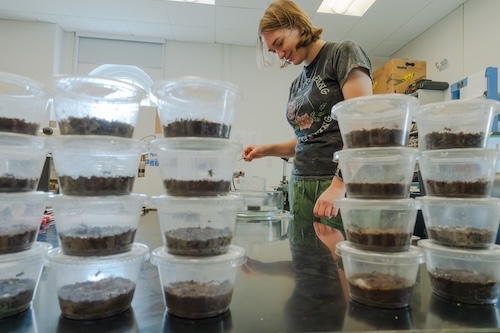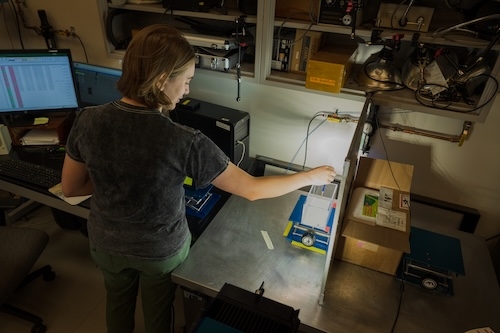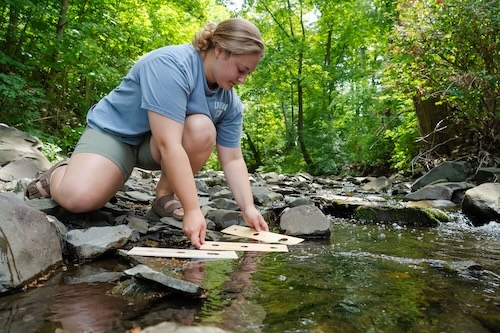In a third-floor lab in Butterfield Hall, Maya Corridore ’27 takes a pair of metal forceps and extracts a young cricket from a glass bowl filled with the insects. She delicately places the cricket into a small separate container holding a singular tiny wolf spider.
In seconds, the voracious spider devours most of the cricket.
“She’s just chowing down on one of her crickets, trying to get that done as soon as she can,” Corridore explains.
Working with Kate Feller, assistant professor of biological sciences, and Michael Sitvarin, visiting assistant professor of biological sciences, Corridore is investigating how hunger level affects escape performance in wolf spiders, or Pardosa milvina.
“These spiders don't actually build webs but rather actively hunt down their prey, and I'm manipulating the number of crickets they get to produce satiated and hungry treatment groups,” said Corridore, a biology major from Columbus, Ohio.
Her research is building upon last summer's work by Maryann Fuentes ‘26, who investigated how hunger level affects the predation of these wolf spiders. She found that satiated Pardosa were captured in a single attack significantly more often than hungry ones.
Corridore is trying to determine if hungry Pardosa achieve greater speeds and accelerations when escaping a predator, making them harder to catch.
Corridore is among a record 155 students across disciplines engaged in paid research this summer. Most projects are funded through the College’s undergraduate research program. The rest are supported by government, foundation or scientific society grants to faculty members and academic departments. The Lee L. Davenport (Class of 1937) Summer Research Fellowship supports 36 projects in engineering, chemistry, biology, physics and geology.
During weekly summer seminar series, student researchers present their work in elevator pitches, hear about innovative research and scholarship conducted by Union faculty, and participate in professional development activities led by Lynn Evans, director of fellowships and doctoral pathways, and Jenna Pitera, assistant librarian.
A poster session highlighting many of the summer projects will be held Thursday, July 24, from 12:30 to 1:30 p.m. in Schaffer Library.
“Our summer research program allows our students to take what they've learned in the classroom and apply it to making the world a better place by answering complex questions, resolving real-world problems, and creating works of art in our labs, archives, studios, and field sites,” said Matthew Anderson, director of undergraduate research and associate professor of computer science.
“Every student collaborates closely with their expert research mentor, who generously shares their knowledge of their discipline; but also their wisdom and experience. Our summer fellows build practical research, communication and collaboration skills that benefit them even if they don't pursue a career in research or scholarship.”
For more than 40 summers, Union has fostered close working relationships among thousands of students and faculty as part of its longstanding commitment to undergraduate research.
In nearly every corner of campus, one can find students pursuing a diverse mix of projects.
Daniel Buletza ’26 spends much of his time in Schaffer Library. An English major with a Spanish minor, Buletza plans to write a creative nonfiction piece about his mother, Sharon, and her experiences growing up in the south of Ireland during the 1970s and 1980s.
The daughter of devout Catholics, Sharon came of age at a time of significant social, political and economic changes. She left her family behind and came to the U.S. to attend Harvard and never looked back.
To familiarize himself with the context, Buletza has been devouring historical and cultural books about the country. He’s also reading examples of the Irish memoir genre, including Frank McCourt’s “Angela’s Ashes” and “The Speckled People: A Memoir of a Half-Irish Childhood,” by Hugo Hamilton.
He’s also conducting extensive interviews with his mother, a human resources executive in Ipswich, Mass.
“She was very flattered and surprised when I told her I wanted to do this project,” said Buletza, who is mentored by Claire Bracken, professor of English. “She didn’t realize the importance of the Irish side of my heritage is to me. Ireland is a place she left behind to come to America. I’ve been to Ireland many times, and it’s a place I enjoy. I wanted to understand more about her experiences.”
Ava DuBoff ’26 is working with Carolyn Rodak, associate professor of environmental engineering and chair of civil and environmental engineering, to design and construct a floating wetland in the lab as a water treatment technique.
An environmental science major with a concentration in ecology, DuBoff said her research will focus on whether wetlands are an effective remediation technique for the filtration of heavy metal polluted water, and can an artificial floating wetland using only natural and nature-based solutions be built?
“We'll be using a species of dwarf horsetail and hope to test how the plant uptakes heavy metals such as zinc and copper,” she said. “We're aiming to use only natural materials, as this project could be later installed in an outdoor location such as the Hans Groot Kill on campus. We anticipate doing multiple test trials as this project will continue as my senior environmental science thesis in the fall.”
Three students were selected this summer as Evans Research Fellows in the College’s Special Collections and Archives. The three, all members of the Class of 2026, are working on separate projects.
Amelia Keese is delving into the life Jonathan Pearson (1813-1887), professor and administrator whose diaries provide an authoritative account about 19th century Union history. Jane Mae Schreiner is researching student photography and Shui Kong Yuen ’42, whose photographs depict campus life in the early 1940s. Ben Stern is examining the history of Jewish individuals at Union.
The Evans Fellows are assisted by Joseph Lueck, Special Collections outreach and reference archivist.
Meanwhile, back in the Butterfield lab, Corridore places a hungry spider in a plastic arena. She positions a high-speed camera that captures their movement at 2,500 fps (frames per second). She pokes the spider with a small paintbrush to simulate an attack from a predator. The footage is digitized using a machine learning program, allowing her to determine each spider’s speed and acceleration.
The idea is to see whether hungry Pardosa can escape faster from a predator due to their significantly lower mass and if heavier, satiated Pardosa need more time to get away.
“If there is no significant difference in escape performance between hungry and satiated Pardosa, predators may put more effort into catching well-fed prey that provide them with more nutrients and energy,” Corridore said.
She plans to pursue a Ph.D. in animal behavior. She chose Union in large part because it is a small liberal arts college that affords students excellent research opportunities.
“Union offers opportunities to build closer relationships with your mentors and other research students,” Corridore said. “I came here because research was an option.”
Learn more at the Undergraduate Research website.
VIDEO: A wolf spider darts across its enclosure, attempting to evade a simulated predator.




